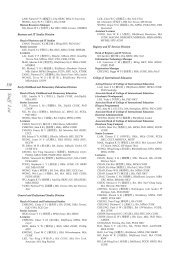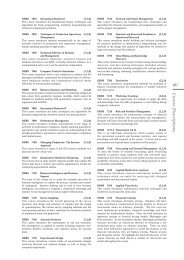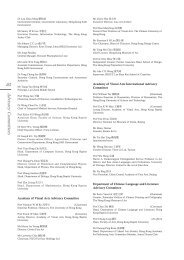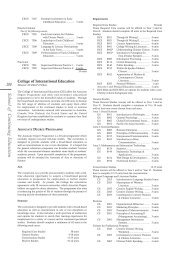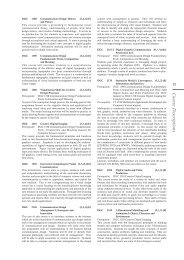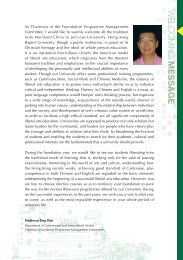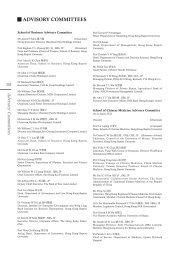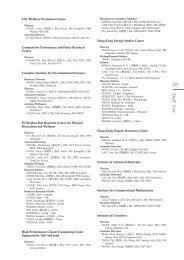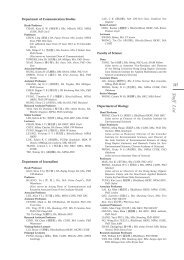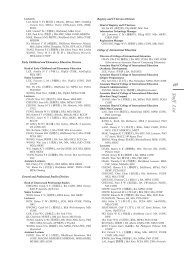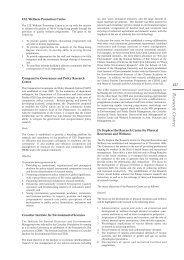352<strong>Course</strong> <strong>Descriptions</strong>GCLA 1009 <strong>University</strong> English II (3,2,1) (E)This course, as a continuation of <strong>University</strong> English I, adoptsthe same approach to reinforce the learning outcomes at a moreadvanced level. Students will have extensive opportunities toread and listen to, as well as discuss and write about, major issuesarising from each selected contemporary theme. Students willlearn to read and analyse the issues critically and from multipleperspectives to gain a deeper understanding and insight, andto present their arguments and points of view convincingly inclass and in writing. Advanced academic and professional skills(synthesizing, debating, panel discussion, etc.) are distributed andexplicitly practised in the course.GCNU 1005 Beating the Odds (3,3,0) (E)This course begins with a list of well-selected and counterintuitiveexamples to help students become aware of the existence ofmathematics in every aspect of our lives. Chance plays a hugepart in life; one will have a better management of risk andopportunities and hence higher odds to become a winner inlife if he knows more about how probability works. Ratherthan focusing on calculating a few specific combinations orpermutations, which are tiresome and tedious to most, this courseuses real-life situations as incentives and utilizes mathematics asa tool to figure out the “Best Bet” in some everyday problems.Casinos and games are topics commonly seen in probability; afterequipping students with the knowledge necessary for identifyingthe “Best Bet”, we move on to a very practical problem—knowingthat the chance of winning is 99.9%, how much should we investon this “Best Bet”? Our investigations (not the formulas andcalculations) are then extended to cover more real-life situationsin which its odds cannot be predicted by counting techniques.Students will discover new ways of expressing known information,connecting reality to math, applying meta-tools to predict chances,and making statistically-justifiable decisions.GCNU 1006 Discovering <strong>Hong</strong> <strong>Kong</strong> by (3,3,0) (E)Statistical SoftwareThis course serves as an introduction to statistical analysis,engaging basic descriptive statistics and advanced regressionmodels. Students often memorize the relevant equations andsymbols without understanding the reasoning and motivationsbehind them, which is not a student-friendly approach tolearning statistics. Here, we skip all of the hard statisticalideas in distribution, formulas or calculus, which differs fromtraditional courses targeting major-students. Rather, this courseis concerned with the logical processes involved in obtaininganswers. Statistical software is useful in helping students graspthe underlying concepts involved. Students are able to follow theappropriate steps and engage with the innovative pedagogy. Thiscourse uses examples from real-life situations and local data,rather than complicated calculations, to guide students in buildinga strong foundation in statistical thinking, which enables themto develop problem-solving techniques and to criticize statisticalarguments. This course can also open up a window into the useof statistics, which will encompass not only simple descriptivestatistics, but also other influential methods including statisticaltests. Ultimately, students will conceptually come to know moreabout statistical tests than their mouse-clicking counterparts.GCNU 1007 Estimating the World (3,3,0) (E)This course begins by introducing the motivations behind whywe need to estimate. While simple estimations can be doneeasily with pen and paper, more complicated ones will require thehelp of modern computing algorithms. To become proficient incomputing, students will learn the differences between familiarmathematical operators (i.e. addition, subtraction, multiplicationand division) and operations (i.e. square root and exponential),as well as the corresponding operators and operations built intocomputers. Equipped with the “computational senses”, students(who are assumed to have no previous exposure to calculus andlinear algebra) will be introduced to several carefully selectednumerical methods applicable to real-life applications, whichare simulated with the aid of the popular mathematical softwareMATLAB. Similar to how today’s researchers approach researchtopics and handle newly invented algorithms, we will adopt astep-by-step investigative experimental approach instead of atheoretical one. This course will guide students to experience andunderstand the essence of estimation via computing by buildinglinks to several basic mathematical ideas, such as sequences andlimits. Although numerical methods covered in this course arelimited, their applications to real-life problems are not. Thiscourse aims to transform the next generation of citizens in <strong>Hong</strong><strong>Kong</strong> from a fact-consumer into informed question-asker, withtopics such as, “How can I estimate the Gini index for <strong>Hong</strong> <strong>Kong</strong>using basic facts and data?”, “How polluted is the air inside thecross harbor tunnel?” and “Taking inflation into account, is thecost of raising a child in <strong>Hong</strong> <strong>Kong</strong> really $4 million?” Underthis course, logical thinking and scientific reasoning combinedwith hands-on experiment will allow students to verify thetrustworthiness of quantitative estimations reported in the newsand its impact on daily life.GCNU 1015 Manage Your Money without (3,3,0) (E)FormulasThis course begins with an introduction to different typesof interest arisen in e.g. savings, student loans, credit cards,mortgages and life insurance policies, followed by basic growthmodels and the more complicated annuity models commonlyfound in <strong>Hong</strong> <strong>Kong</strong>. An EXCEL Tutorial will also be includedin order to introduce the computer skills needed to model andsolve problems using EXCEL spreadsheets. We will also covermore advanced ideas including forecasting trends in interestrates, estimating the market-price behavior, and carrying outsimulations. This knowledge will allow students to select thebest deals from the overwhelming number of plans offered by<strong>Hong</strong> <strong>Kong</strong> financial institutions. Local examples not onlyprovide a sense of familiarity for students, but also make the skillsacquired in this course applicable to <strong>Hong</strong> <strong>Kong</strong> situations. Theseexamples will help build a strong foundation in logical thinkingand problem solving and enable students to use cost-benefitanalysis as a decision-making tool in their daily lives. We hopethis course will help students learn to enjoy using mathematics inreal life.GCNU 1016 Mathematics around Us (3,3,0) (E)This course aims to “make sense” of the mathematicaltopics <strong>Hong</strong> <strong>Kong</strong> students spend years to learn (mainly forexaminations). Although the compact syllabus in high schoolmakes good use of students’ golden learning years to improvetheir calculation skills, the standalone and often unrelated topicscan result in a lack of connections and linkages to real-life.Students may wrestle with abstract mathematical concepts androbotic calculations that appear to be unpractical. To changethe already-frustrated students’ view towards mathematics andallow them to enjoy and benefit from mathematics, a deeperunderstanding of both the foreground (i.e. real-life applicationsaround us) and background (i.e., motivation and origin) mustbe provided. Don't let years of efforts end in vain! This coursebegins with the mathematical logic in our daily conversions. Thispractical opening provides students a sense of familiarity andallows them to gradually see the usefulness of mathematics. Toanswer a common question from students, “Why am I learningthis?”, The interconnections between high school geometry,trigonometry functions (i.e. sin, cos, and tan), Pi, nature numbers,and complex numbers will be built from a historical and practicalpoint of view. The applications of these high school topics indaily life and beyond will also be presented, in the hopes that theymay capture students’ imaginations.GCNU 1017 Mathematics of Fairness (3,3,0) (E)This course begins with an introduction to the way in whichstatistical information can be used to interpret and affect electionphenomena and other everyday issues. Students will learn anumber of election systems and address the problem of finding the
est decision-making procedures. Moreover, a variety of possiblemethods of electing our future Chief Executive are investigated(although we cannot promise you that he or she will ever beelected through universal suffrage). After equipping you with theknowledge of different electoral systems, we then introduce youto the weighted voting system, in which voters may be treatedunequally. Next, the course turns to an investigation of a numberof simplified but real-life cases, such as the distribution of seatsin the Legislative Council of <strong>Hong</strong> <strong>Kong</strong>. Finally, we addressthe mathematically well-known cake-cutting problem, which isformally known as the fairness problem. You will find the answerto many fairness-related questions in this course.GCNU 1025 Numbers Save the Day (3,3,0) (E)Numbers play numerous roles in our everyday lives. They areused to describe the natural world, to communicate information,and to model important daily applications. This course beginswith a simple math topic: “integers 1, 2, 3,…” and guidesstudents through its important (unknown to most) propertiesand everyday applications. After a reminder about the basicproperties of numbers, besides the obvious example of telephonenumbers, students will begin to see the how “features” can behidden within, say, our HKID number. From “fun to know” to“extremely important” applications, topics will range from suchthings as the composition of digital pictures and photo-touchingsoftware to security that helps us assess the risk of everyday onlinetransactions (which is based completely on “numbers”). With anewfound awareness of “numbers” around them, students canmake sense of many more things in their daily lives. We hope thatthis course will help students see the many diverse applications ofmathematics and what makes it all possible.GCNU 1026 Smart Decisions (3,3,0) (E)This course focuses on finding the best way to solve a givenproblem—the so-called operations research, management science,or optimization methods. We begin with a walk-through to helpstudents see the hidden mathematics, or mathematical model,behind seemingly unrelated real-life situations, such as, “Whatis the quickest way check out a shopping mall or a tourist area?”While small-scaled problems can usually be solved by intuitionor trial-and-error, a logical and systematical approach must beused to tackle the large-scaled ones. One of our main goals is togeneralize the concept of “function” learned in high school andextend its applications to real-life problems. Students will learnthat functions can take in different inputs other than real numbers;for examples, the route one decides to go around in the shoppingmall is an input. Identifying the appropriate “function” is highlysituational-dependent which is exactly where students can buildthe connections between real-life and mathematics. Insteadof presenting cookbook-procedures as is (which we find dull,meaningless, and inflexible), we will help students understandall motivations behind the solution process; say, “How hard isthe problem really?” For difficult ones (even with today’s speedycomputers), it makes sense to go with the second-best or nearoptimalapproach than insisting on having the “best” way. Wehope that this course will help students getting used to “practicalmathematics”and benefit from doing so in their future careerachievements.GCNU 1027 Speaking of Statistics (3,3,0) (E)This course begins with an introduction to different ways tointerpret data in a proper statistical sense or misinterpret datawith unjustifiable arguments. Misuse of statistical claims anddata are not at all uncommon in <strong>Hong</strong> <strong>Kong</strong>. To become a smartconsumer or citizen, we must not blindly believe in everythingwe are being told. Even though not everyone is trained to be astatistician or a scholar (which is not what we aim to do either),having some overall idea about how statistics works helps usbe aware of the phony statistics around us and remain doubtfulabout the credibility of various claims. This course uses real-lifeexamples to help students build a strong connection between thepresented materials to the real world. We go easy on calculations;it is more important to understand “What are we doing?” and “Whyare we doing this?” than the actual calculation (which is mostlydone by computer software nowadays). By having the full picturein sight, students can see why a “statistically significant” discoverycan be unimportant or even irrelevant—which is commonly usedto trick people who “think” they understand statistics. We hopethat this course will help students strengthen and apply theirlogical thinking skills effectively to their reading (i.e. by identifyingthe suspicious data), writing (i.e. by producing honest selffavorabledata), and future learning (i.e. by extending the criticalskill to other fields of study).GCNU 1035 Introduction to Spatial Numeracy (3,2,1) (E)The course will teach students mathematical concepts and toolsfor measuring space, location and spatial relationships in termsof distance, direction, location, size, area, etc. These includeplane and spherical geometries such as coordinates, latitude,longitude, Euclidean and great circle distances, etc. The coursewill also introduce basic quantitative spatial models and toolsfor mapping, positioning and navigating, for examples GoogleEarth, Geographical Information Systems and Global PositioningSystems, and satellite images.GCNU 1036 Business Numeracy (3, 3, 0) (E)Taking you clearly and concisely through numerous fundamentalfunctions, both elementary and advanced, this course arms youwith the tools necessary to not only approach numbers withmore confidence, but also solve business numeracy problemsmore easily, analyse information more accurately, and makedecisions more effectively. Quantitative writing assignments (e.g.understanding how economic indicators, market share, marketprice, share prices, financial ratios, volume of units produced,profit margins, cost of living indexes, supply and demand statisticshave impacts on the business environment) in this course willnot only enrich students’ computational ability, but also providean adventure for students to explore, to deduce and to drawconclusions based on numerical or other quantitative evidence.GCPE 1005 Badminton (1,2,0) (C)This course aims to acquaint students with the basic rules,knowledge, as well as the basic motor skills of badminton. It alsoprovides students with an understanding of the principles of ahealthy lifestyle and means to apply fundamental sports scienceknowledge to analyse and enhance badminton performance.Upon completion of this course, students will be able to performthe basic skills of badminton, apply the offensive and defensivestrategies under game situations, and adopt an active healthylifestyle.GCPE 1006 Basketball (1,2,0) (C)This course aims to acquaint students with the basic skills andtechniques of basketball. It also provides students with anunderstanding of the principles of a healthy lifestyle and meansto apply fundamental sports science knowledge to analyse andenhance basketball performance. Upon completion of the course,students will be able to perform basketball techniques in shooting,dribbling, passing and catching; understand the competition rulesand scoring method; and adopt an active healthy lifestyle.GCPE 1007 Competitive Sport for People with (1,2,0) (C)Special NeedsThis course aims to acquaint students with the knowledge inthe work of a selected National Sport Association that offerscompetitive sport for people with mobility/sensory/health needs.It also helps students acquire knowledge in physiological andpsychological effects of the selected sport practised by personswith mobility/sensory/health needs.GCPE 1015 DanceSport—Latin Dance (1,2,0) (C)This course aims to acquaint students with the fundamentalknowledge and motor skills in Latin Dance of DanceSport. Italso provides students with an understanding of the principles of353<strong>Course</strong> <strong>Descriptions</strong>
- Page 3 and 4: economic growth, trade, pollution,
- Page 5 and 6: specific empirical economic problem
- Page 7 and 8: of private enterprises in the indus
- Page 9 and 10: period. The first part of the cours
- Page 11 and 12: The reactions and effectiveness of
- Page 14: 314Course DescriptionsEDUC 3080 Tea
- Page 17 and 18: development of children and adolesc
- Page 19 and 20: and communication skills in differe
- Page 21 and 22: y ubiquitous technology. Learners w
- Page 23 and 24: ENG 2650 Topics in English Grammar
- Page 25 and 26: clause structures of the English la
- Page 27 and 28: adopted for reading and interpretin
- Page 29 and 30: drama; and (2) introduce Western dr
- Page 31 and 32: ENGL 4005 Advanced Topic in Compara
- Page 33 and 34: attendant to the break-up of mediev
- Page 35 and 36: EURO 3205 Comparative Politics of (
- Page 37 and 38: states, enlargement provides signif
- Page 39 and 40: to create and develop ideas via rel
- Page 41 and 42: strategies of awarded campaigns to
- Page 43 and 44: characteristics of films, film-make
- Page 46: 346Course DescriptionsFINE 1005 Fin
- Page 49 and 50: GCHC 1005 China and the Global Econ
- Page 51: the period with a special focus on
- Page 55 and 56: GCPE 1065 Table Tennis (1,2,0) (C)T
- Page 57 and 58: and/or philosophical traditions the
- Page 59 and 60: on the use of English in various se
- Page 61 and 62: GDAR 1835 Music, Mind, and Human (3
- Page 63 and 64: lead to successful development of n
- Page 65 and 66: management and proactive stakeholde
- Page 67 and 68: GDCV 1065 Buildings of Hong Kong: (
- Page 69 and 70: of various religions that broaden t
- Page 71 and 72: their implications for contemporary
- Page 73 and 74: gone through since 1945 included th
- Page 75 and 76: GEOG 1005 Geography and the Contemp
- Page 77 and 78: students to the concepts and techni
- Page 79 and 80: GEOG 3730 Energy Policy and Analysi
- Page 81 and 82: processes interact with China’s s
- Page 83 and 84: GERM 1006 German II (3,3,0) (G)Prer



